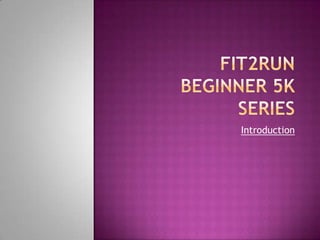
Learn Natural Running Form for Greater Efficiency
- 1. Introduction
- 2. 6:30 – Running Talk 6:50 – Stretch 7:00 – Run 7:30 – Cool Down 7:45 – Adjourn Thisschedule is flexible. Sometimes we will not talk as long, sometimes we will talk more. In any case it will be FUN!!
- 3. Who are you? Why do you want to run? What is your fitness background? What is your athletic fantasy?
- 5. NATURAL RUNNING FORM How humans run without the influence of footwear
- 6. WHAT IS NATURAL RUNNING FORM? Abebe Bikila Zola Bud World marathon Record, Rome Olympics, 1960 2x 5,000 meter world record holder
- 7. NATURAL HUMAN GAITS • WALK - very efficient over long distance • Straight legs • Heel strike • Stance phase • Toe off • Both feet on the ground together • RUN - very efficient over long distance • Land under center of mass • Lateral midfoot/forefoot strike • Stance phase • Toe off • One foot on the ground at a time • SPRINT - up to 30 seconds • Fully propulsive • Forefoot strike
- 8. LEARNED HUMAN GAIT • JOGGING (running with a walking gait) • Difficult to maintain for long distances • Heel strike (braking) • Stance phase • Toe off • Ground contact like walking • Stance phase like running • Toe off like sprinting
- 9. NATURAL RUNNING GAIT Vertical oscillation land load lever lift
- 10. INEFFICIENCIES OF SHOD RUNNING 1. Upper body upright or leaning back contribute to overstriding 2. Overstriding A. Unnecessary muscular effort lifting lower leg B. Lower leg extension in front of the knee: increased inertial mass moving opposite direction of movement) C. Foot loaded with the ground in front of the bodies center of mass = braking until midstance D. More time on the ground = longer stride length and lower cadence 3. Dorsiflexed foot A. Unnecessary muscular effort B. Leads to heel engagement and loading (increased risk of injury) 4. Vertical Oscillation = increased effort lifting bodyweight 5. Lateral motion expends energy in wrong direction (bleeds off speed) 6. Reduced elastic recoil from connective tissue
- 11. INEFFICIENCIES OF SHOD RUNNING 1. Upper body too upright 4. Lateral motion (over rotating to counterbalance overstriding) 2. Overstriding 3. Dorsiflexed foot
- 12. EFFICIENT INEFFICIENT CRAIG ALEXANDER TERENZO BOZZONE
- 13. BRAKING AND IMPACT FORCES SUSPENSION ON MUSCLE & TENDON IMPACT ON YOUR STRUCTURE & JOINTS
- 14. VERTICAL OSCILLATION • Running 7 mph at 160 steps per minute, a (typical western) runner: • Uses 1,371 steps per mile • Moves 6 inches vertically per step • Lifts their body 9,257 vertical inches = 771 ft per mile • Over a marathon, this is 20,200 ft = 3.8 miles climbing • Highly efficient runners running at 7 mph have 180 steps per minute • Uses 1,543 steps per mile • Moves 2 inches vertical per step • Lifts their body 3,086 vertical inches per = 257 ft per mile • Over a marathon, this is 6,733 ft = 1.3 miles of climbing • Save 2.5 miles vertical climbing effort
Notas del editor
- What is Natural running? For over 15 years Boulder Colorado based Newton Running has been studying how humans run (without footwear) on a natural surface. The foot plant is light and contacts the ground mid foot or forefoot first , sensing the ground , body mass is over the landing mass for balance, heel settles downward after touchdown to allow the lower body muscle and tendon to load and recoil energy, upper body leans slightly forward to allow gravity to pull us forward and the cadence is quicker to self regulate impact and keep up with the forward pull of gravity. It feels light and easy! Take your shoes off and run across the floor, notice how the body automatically knows how to run correctly.This is Natural Running! This is the way we were all born to run!From this information Newton Running shoes were developed to be a more natural extension of your foot. Allowing the runner to be centered with gravity. Allowing the foot to work with the shoes more naturally. Maximizing sensory input, energy return and shock absorption for Unnatural surfaces.
- Natural Running Form with Newton Running shoes. Without high heel pitch the foot sets up parallel to the landing surface. The foot lands under the body mass mid foot/ forefoot , heel settles to the ground recoiling spring tension from the lower body.Now simply lift the foot off the ground instead of pushing.Repeat.Upper body stays slightly forward , shoulders square, elbows pull back , arms relaxed and at 90 degrees head stays level and looking forward.
- Natural Running Form with Newton Running shoes. Without high heel pitch the foot sets up parallel to the landing surface. The foot lands under the body mass mid foot/ forefoot , heel settles to the ground recoiling spring tension from the lower body.Now simply lift the foot off the ground instead of pushing.Repeat.Upper body stays slightly forward , shoulders square, elbows pull back , arms relaxed and at 90 degrees head stays level and looking forward.
- Natural Running Form with Newton Running shoes. Without high heel pitch the foot sets up parallel to the landing surface. The foot lands under the body mass mid foot/ forefoot , heel settles to the ground recoiling spring tension from the lower body.Now simply lift the foot off the ground instead of pushing.Repeat.Upper body stays slightly forward , shoulders square, elbows pull back , arms relaxed and at 90 degrees head stays level and looking forward.
